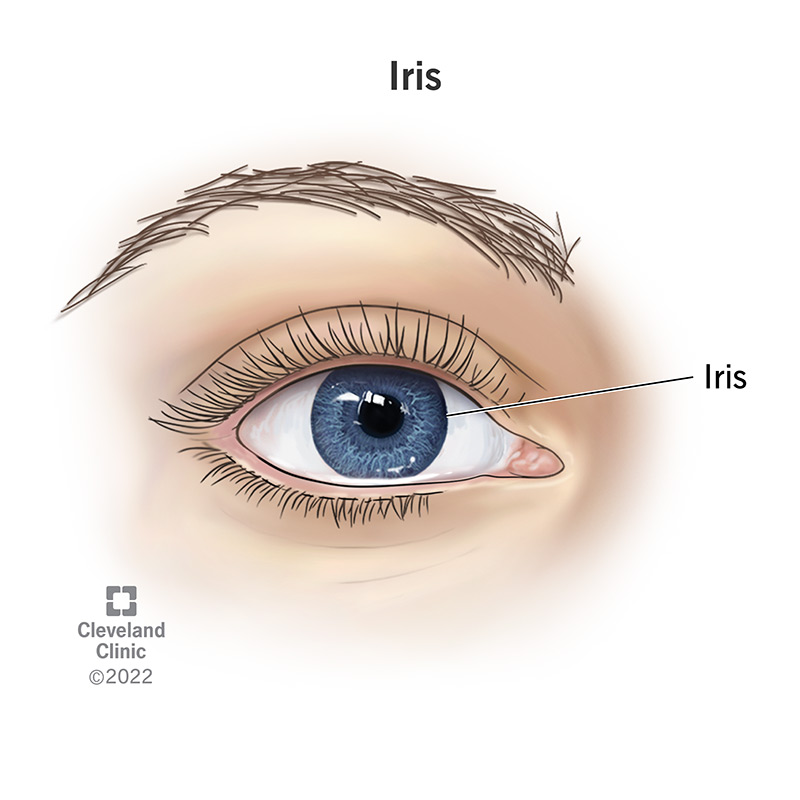The color of your iris is unique, just like your fingerprint. It automatically changes to let more or less light into your pupil. Visit an eye care specialist if you ever notice any changes in your vision or if you’re suddenly sensitive to changes in lighting.
Advertisement
Cleveland Clinic is a non-profit academic medical center. Advertising on our site helps support our mission. We do not endorse non-Cleveland Clinic products or services. Policy

The iris is the colored part of your eye. Muscles in your iris control your pupil — the small, black opening that lets light into your eye.
Advertisement
Cleveland Clinic is a non-profit academic medical center. Advertising on our site helps support our mission. We do not endorse non-Cleveland Clinic products or services. Policy
The color of your iris is like your fingerprint — it’s unique to you, and nobody else in the world has the exact same colored eye as you.
The iris works with the rest of your eye to help you see. Specifically, it controls how much light enters your eye. Muscles in your iris adjust your pupil automatically based on changes in lighting. When your pupil widens (dilates), more light gets into your eye. When it narrows (contracts), less light gets in.
Your iris squeezes or releases your pupil to change the amount of light that reaches the rest of your eye. This constant change in size helps you see in lighter and dimmer places. Your iris adjusts your pupil without you controlling it or thinking about it.
You can notice your iris working when you step outside on a bright day or come inside after some time in the sun. The time it takes your eyes to adjust to the light is your irises adjusting your pupils.
The iris surrounds the pupil at the center of your eye.
Your eyeball has several layers that sit on top of each other, like an onion. The iris is one layer from the outside — under the cornea and on top of the lens.
The iris is the part of your eye that’s colored. It’s flat and round.
Your eye color depends on how much melanin (a naturally occurring pigment) your body makes and certain genes. The genes that determine your eye color are passed down from your biological parents.
Advertisement
The iris is made of muscles and nerves. They work on their own without you thinking about them (parasympathetically) to control the size of your pupil.
Any eye condition can affect your iris, including:
Eye injuries can damage any part of your eye. How an injury affects your iris depends on what caused it. Some eye injuries heal with rest and at-home treatments. Others can cause serious eye damage and vision loss. Visit an eye care specialist or go to the emergency room if you experience an eye injury.
An eye care specialist will check your irises as part of your overall eye exam. They might use a slit lamp exam to see into your eyes.
If your eye care specialist needs to check your eyes for a specific condition or issue, you might need some imaging tests, including:
Wear sunglasses with 100% UV protection or a UV400 label anytime you’re in the sun.
Visit an eye care specialist as soon as you notice any changes in your vision. Whether it’s something as simple as needing new glasses, or a more serious condition, don’t wait for symptoms to get worse before having your eyes checked.
Go to the emergency room if you suddenly lose your vision or experience severe eye pain.
Scanners that use your face and eyes are increasingly common ways to unlock phones, computers and other security devices. These scanners bounce a small amount of infrared light off your face and eyes to verify your identity. There’s no evidence these devices are dangerous or can harm your eyes.
The iris is like a colored fingerprint that’s unique to you. But it does more than give you a one-of-a-kind eye color. Your irises play an important role in your ability to see clearly in every situation. Get regular eye exams to make sure your eye care specialist can identify any changes in your eyes before they affect your vision.
Advertisement
Getting an annual eye exam at Cleveland Clinic can help you catch vision problems early and keep your eyes healthy for years to come.

Last reviewed on 07/24/2024.
Learn more about the Health Library and our editorial process.